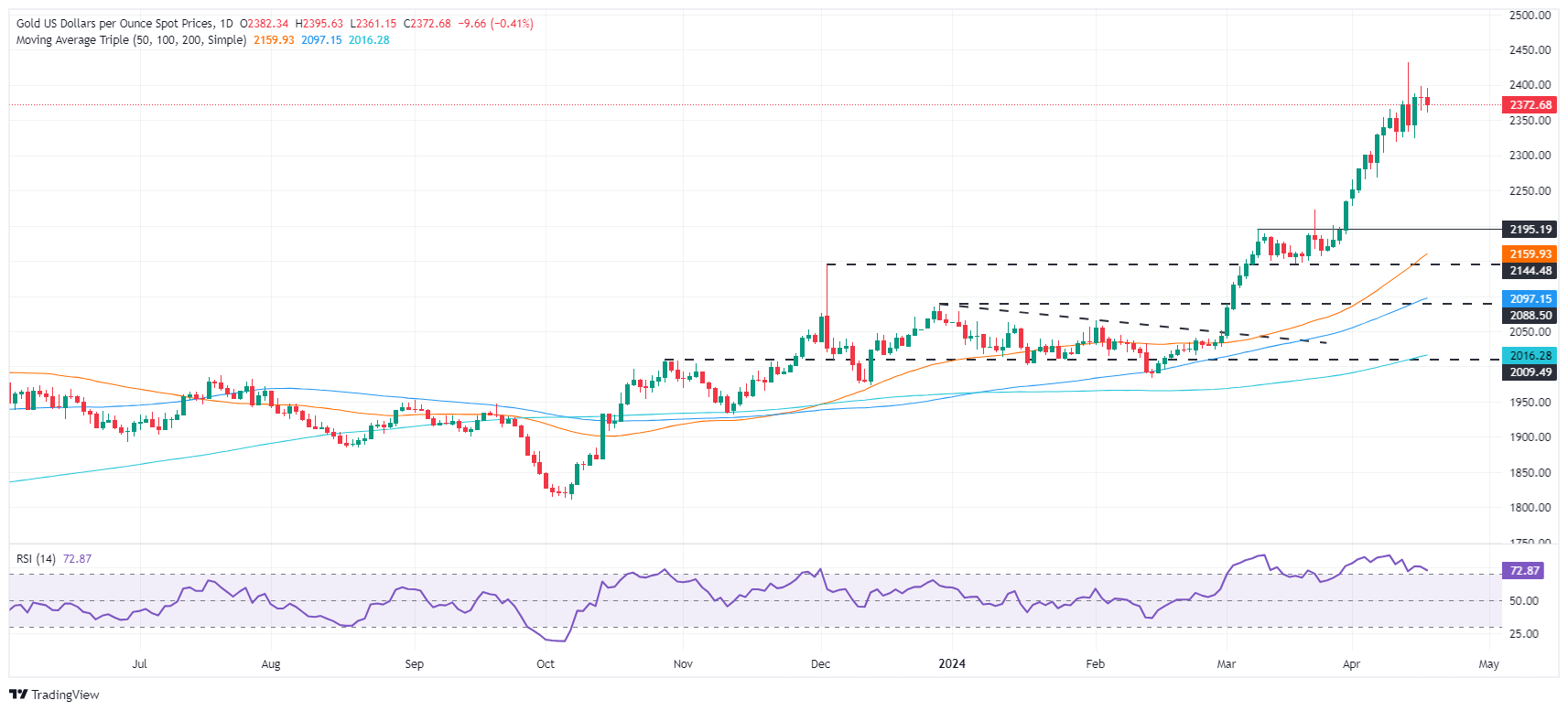- Gold price falls from daily highs as improving global risk sentiment dampens safe-haven demand.
- Falling US Treasury yields put additional pressure on the US Dollar amid hawkish comments from the Fed.
- The easing of tensions in the Middle East influences the Gold market, the upcoming US sanctions on Iran could influence future prices of precious metals.
Gold prices retreated from near weekly highs during the North American session on Wednesday amid improving risk appetite. The bullish momentum came despite hawkish comments from officials at the US Federal Reserve (Fed). US Treasury yields fell and undermined the Dollar, halting the decline in Gold.
XAU/USD is trading at $2.375, losing 0.34%, after reaching a daily high of $2.395, on the verge of surpassing $2.400. Tensions in the Middle East had calmed after Israeli officials said they considered attacking Iran on Monday but decided to wait, according to Axios. Meanwhile, the US will impose new sanctions on Iran in the coming days, said Jake Sullivan, White House national security adviser.
Returning to economic issues, Fed Chairman Jerome Powell stated that the US economy has performed quite solidly, while acknowledging that the latest data show the lack of further progress in terms of inflation.
Daily Market Moves: Gold Falls Amid Falling US Yields, USD Weakness
- Jerome Powell added that “recent data clearly have not given us greater confidence and instead indicate that it will likely take longer than expected to achieve that confidence” that inflation is on track for 2%. In his opinion, “given the strength of the labor market and the progress made so far on inflation, it is advisable to give more time to restrictive policy and let the data and the evolution of the outlook guide us.”
- The latest US economic data indicates a robust economy, highlighted by February retail sales, which exceeded expectations, and stable industrial production numbers. These positive indicators have helped alleviate concerns raised by weaker-than-expected real estate data released on Wednesday.
- Meanwhile, CME's FedWatch tool shows the first rate cut could come in September, with the odds of a quarter-percentage-point cut at 71%.
- Despite the good US economic data, market participants appear to be focused on geopolitical risks. Sources cited by The Jerusalem Post revealed that Israel had finalized plans to counterattack Iran.
- The US Dollar Index (DXY), which tracks the dollar against a basket of six other currencies, lost 0.15% to 105.96.
- Gross Domestic Product (GDP) estimates for the first quarter of 2024 show the US economy will grow 2.9%, up from 2.8% estimated on April 15, according to Atlanta's GDPNow model.
Technical analysis: Gold sinks as RSI almost breaks out of overbought levels

The daily gold chart shows the yellow metal with a bullish bias despite retreating towards the $2,370 area. The formation of a Doji on Tuesday suggests that buyers lack momentum to extend the precious metal's gains, opening the door for a pullback.
Furthermore, the Relative Strength Index (RSI) has fallen below the 80 level and has not looked back as it is about to cross below the 70 level, suggesting that the buying pressure is fading. .
That being said, XAU/USD is heading towards a correction. The first support would be the $2,350 mark, followed by the April 15 daily low of $2,324. Once broken, Gold could test the $2,300 level.
On the other hand, if buyers drag prices towards $2,400, a test of the all-time high of $2,431 is expected.
Frequently asked questions about Gold
Why invest in Gold?
Gold has played a fundamental role in human history, as it has been widely used as a store of value and medium of exchange. Today, apart from its brilliance and use for jewelry, the precious metal is considered a safe haven asset, meaning it is considered a good investment in turbulent times. Gold is also considered a hedge against inflation and currency depreciation, since it does not depend on any specific issuer or government.
Who buys more Gold?
Central banks are the largest holders of Gold. In their aim to support their currencies in turbulent times, central banks tend to diversify their reserves and purchase Gold to improve the perception of strength of the economy and currency. High Gold reserves can be a source of confidence for the solvency of a country. Central banks added 1,136 tons of gold worth about $70 billion to their reserves in 2022, according to data from the World Gold Council. This is the largest annual purchase since records exist. Central banks in emerging economies such as China, India and Türkiye are rapidly increasing their gold reserves.
What correlation does Gold have with other assets?
Gold has an inverse correlation with the US Dollar and US Treasuries, which are the main reserve and safe haven assets. When the Dollar depreciates, the price of Gold tends to rise, allowing investors and central banks to diversify their assets in turbulent times. Gold is also inversely correlated with risk assets. A rally in the stock market tends to weaken the price of Gold, while sell-offs in riskier markets tend to favor the precious metal.
What does the price of Gold depend on?
The price of Gold can move due to a wide range of factors. Geopolitical instability or fear of a deep recession can cause the price of Gold to rise rapidly due to its status as a safe haven asset. As a non-yielding asset, the price of Gold tends to rise when interest rates fall, while rising money prices tend to weigh down the yellow metal. Still, most of the moves depend on how the US Dollar (USD) performs, as the asset is traded in dollars (XAU/USD). A strong Dollar tends to keep the price of Gold in check, while a weaker Dollar is likely to push up Gold prices.
Source: Fx Street
I am Joshua Winder, a senior-level journalist and editor at World Stock Market. I specialize in covering news related to the stock market and economic trends. With more than 8 years of experience in this field, I have become an expert in financial reporting.







